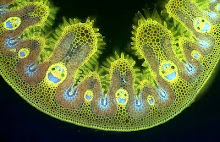As spring approaches, what plants spring to mind? Snowdrops? Primroses? Daffodils? If you lived in the Pacific Northwest of America your list might also include the imposing skunk cabbage Lysichiton americanus.
Another skunk cabbage species, Symplocarpus foetidus, is a thermogenic plant, emitting enough heat from that central club-shaped spadix to melt surrounding snow , although L.americanus isn't thermogenic. If you take a look at http://5e.plantphys.net/article.php?ch=&id=503 you can see a thermal image of another aroid, Philodendron flower, a relative of skunk cabbage, showing how the central spadix generates heat.
L. americanus has a slightly unpleasant smell that attracts beetle pollinators in its native habitat. This certainly works here in England too, half a world away from home - the skunk cabbage in my bog garden attracts pollinators , although here its flies rather than beetles that are attracted to its aroma.
The flower buds on the plant in my garden are just beginning to elongate and will be fully open in two or three weeks. After they wither they're replaced by very large waxy green leaves which were once used as the botanical equivalent of waxed wrapping paper. The climate in the UK suits this plant well and I know of one local woodland close to the River Wear where a colony has been thriving in a swampy hollow between the trees for almost two decades - almost certainly a garden throw-out that has been swept down river and established itself in the wild.















